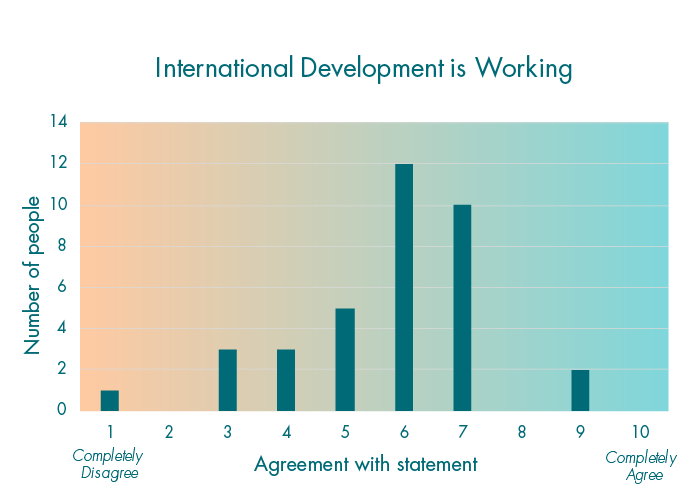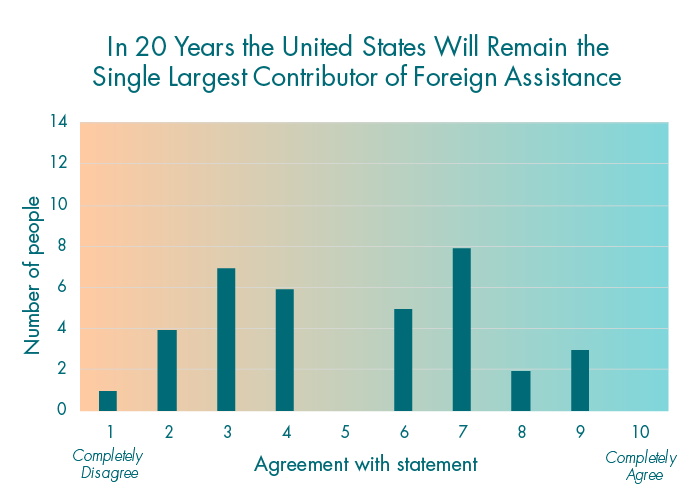Calling all young professionals in international development—CGD wants to know what you think. In today’s world of protracted conflicts, accelerated migration flows, and growing nationalism, demand is rising for innovative solutions in development. Capitalizing on your perspectives as future leaders in development is critical to ensure our field’s adaptability and sustainability.
That was our priority when CGD recently hosted “Young Professionals and the Future of Global Development,” an interactive conference event, designed to gather input from early-career professionals on where international development is headed—and how to steer it—in the decades ahead. In this blog post we present some of what he heard and learned at the event—and you can also watch our video recap below.
The event was split into three sections, inviting participants to break out into smaller discussion groups, and to vote with their feet on certain issues. To kick off, we held a discussion among five young panelists from diverse development organizations including the World Bank, the Millennium Challenge Corporation, Devex, and the Center for Global Development.
When asked how the development community should better anticipate its most urgent challenges in the next 10-15 years, panelists’ responses ranged widely but shared a few common elements. First, they agreed that the world’s increasingly transnational problems demand better global coordination and a sharper focus on public goods. Rebekah Smith, migration policy analyst at the World Bank, highlighted labor mobility as an area ripe for building “global skills partnerships,” arrangements that match surplus labor—particularly that of displaced people—to job gaps in economies around the world. Similarly, MCC Development Policy Officer Ami Amin and CGD Policy Analyst Janeen Madan both stressed that preventing and containing pandemic diseases would require greater global cooperation.
Second, panelists emphasized the importance of interdisciplinary thinking to achieving development outcomes. Krishnan Raghavan, soon-to-be graduate of Johns Hopkins SAIS, posited that because poverty will be increasingly concentrated in fragile and post-conflict states, the conflict management, humanitarian, and development communities should work closely together to devise innovative strategies tailored to individual fragile-state contexts. This echoed a recent report by CGD and IRC on how to bridge the humanitarian-development divide to better help the world’s 21 million refugees. Madan, who also worked on that report, remarked that key development goals like cleaner water and improved sanitation also slow antimicrobial resistance, the rise of deadly supergerms; and Smith and Raghavan pointed out that climate change drives conflict, both of which in turn drive migration flows.
Third, panelists agreed that cost-effectiveness will be paramount going forward. As Amin called for strengthening public health systems, she warned that the rising costs of non-communicable diseases in developing countries are unsustainable. Moreover, given potential US foreign assistance cuts, the panel encouraged the development community to distribute its work efficiently by “knowing the relative advantage of your institution,” in Amin’s words. Specifically, Raghavan pushed for more public-private cooperation, and Smith saw US cuts as an opportunity to empower leaders in the global South to take greater ownership of development priorities.
Kate Wathen, engagement editor at Devex, spotted a different kind of challenge for the development community, that of clear messaging. Development professionals, she argued, are skilled at conveying the intricacies of development priorities to each other, but are less adept at communicating the urgency to outside audiences in a meaningful way. “Nothing kills dinner conversation at my family’s house in the Midwest like [saying] ‘I work in international development,’” Wathen quipped, calling on development actors to reach out to and better connect with these grassroots audiences.
Audience Pulse and Response Graphs
Following the panel discussion, we turned to our audience for their opinions on three aspects of development: overall effectiveness, the role of the US, and operations in fragile states. We began by reading a statement and asked audience members to respond with their feet, moving toward one side of the room or the other to the extent that they agreed or disagreed. Attendees also assigned numerical values to their positions, with 1 representing “I completely disagree” and 10 representing “I completely agree.” We collected 36 numerical responses, which are used as data points in the graphs below.
Statement One: International development is working.
Our audience reached a slim consensus that development is mostly working. Most attendees clustered towards the middle of the room. Those who agreed with the statement cited statistics of lower poverty and increased wealth across the globe. Chris Aubrecht of the European Space Agency at the World Bank said, “we all need a little more optimism” to “convey the message that what we do actually does make sense and is worth doing.”
However, several attendees pointed out failings in international development. Mary Kate Costello of the Hunger Project claimed that current development initiatives are not sustainable and called for better exit strategies. Rashmi K C, an American University student, said she’s seen duplicative, corrupt aid programs in Nepal, her home country. Most numerical responses ranged from 5-7, and the average score was 5.75 out of 10.

Statement Two: In 20 years, the US will remain the single largest contributor of foreign assistance.
The most divisive discussion arose around the future of US foreign assistance. Many attendees said the current political climate will weaken US financial contributions in the short- and long-terms. Others had ideological reasons for wanting the US to maintain strong leadership. Interaction’s Sohiya Sharma wrote, “The US’s values are like no other in terms of human rights and freedom.” Some alluded to dubious geopolitical motives in other parts of the world, considering China’s objectives and environmental safeguards to be questionable at best.
In response, Deji Oloko of CSIS argued that US motives are “not completely innocent,” and said other countries should and will step up in the future. Kin Su of the Society for International Development in Washington took this a step further, writing, “I certainly hope the US will not be the single largest contributor. We should foster more equal and diverse global development partnerships.” These sentiments mirror the numerical responses, which ranged from 1-9 and had clear clusters on either end of the spectrum.

Statement Three: Going forward, donor countries should dedicate fewer resources to stable countries and more to fragile and post-conflict states.
Responses to our third statement were wide-ranging. Alyssa Jackson from the US Institute for Peace strongly agreed, writing, “we will continue to respond [to conflict] until we invest in prevention.” On the other side of the spectrum, Julian Glucroft from MCC opined that a country’s relative stability should not determine where to allocate foreign assistance, which plays an important role in both stable and fragile states.
Other participants were somewhere in between, seeing state fragility as one of many factors for determining aid flows. Reflecting this discussion, numerical responses ranged from 2-10, with an average score of 6.05 out of 10.

Sector Priorities
The last segment of the event invited the audience to form six discussion groups representing six topics: global health, migration, climate change, gender, education, and the private sector. After 20 minutes, each group presented an answer to the following prompt:
In this field or sector, what single challenge will be the most pressing in 10-15 years? Why? What 2 or 3 key steps should the next generation of international development leaders take to better address it?
Each group’s consensus is summarized and captured on video in the expandable table below. Take a look!
Climate Change: “Climate change is a systemic exacerbator.”
“Climate change is a systemic exacerbator” of other development problems, said Abhik Pramanik of the US Global Leadership Coalition. He emphasized that drought and rising ocean levels continue to drive migrant flows and facilitate the spread of disease. The group recommended that the climate change community work extensively with local actors and the private sector and focus more on local resilience to climate shocks.
Private Sector: Good regulations strengthen the private sector but constrain it in the right ways.
This group focused on the relationship between the private sector and corruption and the importance of strengthening public-private partnerships. Setting government regulations that spur private sector growth while constraining companies that incentivize corruption is key, they said. The group also pushed for greater public-private cooperation, noting that businesses should understand their potential for “bridging the financing gap” in development, while rich governments should do more to harness this external finance pool.
Education: “There are more children in schools these days, but they are not learning.”
Despite high educational enrollment worldwide, children aren’t learning in school, the education group asserted. They agreed that restructuring and reallocating finance for education, rather than increasing it, held the most promise for improving learning outcomes. Specifically, Rashmi K C from American University called for “investing more in teacher education, training them rigorously for a long period of time” and sharing knowledge of what works across countries at a faster rate.
Global Health: “Strengthening health systems”
Our global health group pointed to disease surveillance, outbreak prevention and response, nutrition, and health supply chains as key priorities under the umbrella of “health systems strengthening.” Towards this goal, Kerry Ann Dobies from John Snow, Inc. emphasized building relationships with local leaders such as chiefs or village health workers to lend popular legitimacy to government health directives. Stephanie Phipps from Gavi said the field should embrace innovations including performance-based financing tools and electronic registries to further build capacity.
Gender: “Gender should no longer be its own issue area.”
“Gender should no longer be its own issue area,” said Sarah Silverman, a student at the GW Elliott School of International Affairs. This group recommended disaggregating research data by gender to illustrate the cross-cutting nature of gender issues and encourage financial investment in women’s empowerment. The group also stressed designing programs at the grassroots level that incorporate diverse community actors including men.
Migration: Pairing “advocacy and dissemination of results”
Migration has a serious PR problem, this group noted. To change the narrative, development professionals can use “advocacy and [the] dissemination of results” to appeal more strategically to hearts and minds, said Silas McGilvray of Management Sciences for Health. This group also advocated for building institutional frameworks for migration that transcend national boundaries.
Our concluding message to young professionals and young people in general is this: engage with us. Come to our events, subscribe to our newsletter, follow us on Twitter and Facebook, and tell us what you think is working in development, what isn’t, and why. You will help advance CGD’s mission to fight poverty through innovative, evidence-based policies by keeping the dialogues we foster energetic, fresh, and as inclusive as possible.
We look forward to seeing you soon!
Disclaimer
CGD blog posts reflect the views of the authors, drawing on prior research and experience in their areas of expertise. CGD is a nonpartisan, independent organization and does not take institutional positions.

